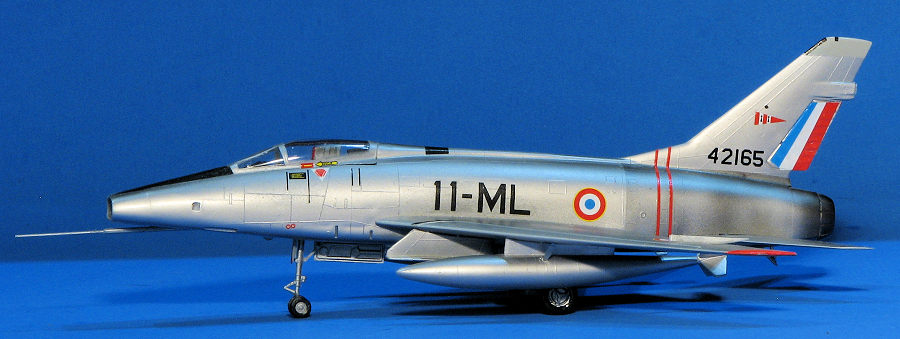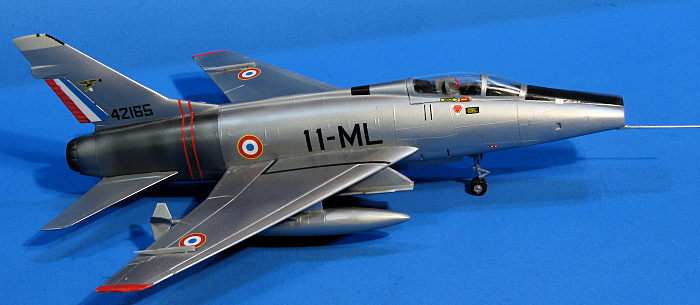
| KIT #: | 02200 |
| PRICE: | 3400 yen |
| DECALS: | Three options |
| REVIEWER: | Scott Van Aken |
| NOTES: | One of two kits in box |

| HISTORY |
 The North American F-100 Super Sabre is an American
supersonic jet fighter aircraft that served with the United States Air
Force (USAF) from 1954 to 1971 and with the Air National Guard (ANG) until 1979.
The first of the Century Series of USAF jet fighters, it was the first USAF
fighter capable of supersonic speed in level flight. The F-100 was designed
by North American Aviation as a higher performance follow-on to the F-86 Sabre air
superiority fighter.
The North American F-100 Super Sabre is an American
supersonic jet fighter aircraft that served with the United States Air
Force (USAF) from 1954 to 1971 and with the Air National Guard (ANG) until 1979.
The first of the Century Series of USAF jet fighters, it was the first USAF
fighter capable of supersonic speed in level flight. The F-100 was designed
by North American Aviation as a higher performance follow-on to the F-86 Sabre air
superiority fighter.
Adapted as a fighter-bomber, the F-100 was supplanted by the Mach two-class F-105 Thunderchief for strike missions over North Vietnam. The F-100 flew extensively over South Vietnam as the air force's primary close air support jet until being replaced by the more efficient subsonic LTV A-7 Corsair II. The F-100 also served in other NATO air forces and with other U.S. allies. In its later life, it was often referred to as the Hun, a shortened version of "one hundred".
| THE KIT |
Back in the early 1970s, Hasegawa pretty well held the lead in terms of the USAF's Century Series fighter kits in 1/72 scale. True, today, these things are woefully inadequate in terms of detail and most modelers will shun this one. However, they are pretty inexpensive as things go, especially when ordering direct and do make into quite passable models for one's display shelves.
This is a 2016 release that has two kits in one box. Unlike the original releases, this one is molded in a standard grey plastic. In addition, the plastic is not as hard as the earlier releases and there is flash on several parts as well as some sink areas that will need to be taken care of. The cockpit is quite Spartan consisting of little more than a seat with radio bits behind it, a floor and a pilot to put into the seat. The instrument panel is molded in with the anti-glare panel and takes a decal for instruments.
 The instructions don't indicate any nose weight, but I'd add some
just to be sure. Both the intake and exhaust pieces are somewhat shallow,
but no worse than what you'd get on the ESCI kit. You only get the early
exhaust so if modeling something from its later history where it had the
F-102 burner can, you'll have to source that from somewhere else. The kit
has a single piece canopy to cover your pretty empty cockpit. Wings have a
full span lower wing with upper halves and separate fences on the outer
wings. All of the pylon holes are already opened up.
The instructions don't indicate any nose weight, but I'd add some
just to be sure. Both the intake and exhaust pieces are somewhat shallow,
but no worse than what you'd get on the ESCI kit. You only get the early
exhaust so if modeling something from its later history where it had the
F-102 burner can, you'll have to source that from somewhere else. The kit
has a single piece canopy to cover your pretty empty cockpit. Wings have a
full span lower wing with upper halves and separate fences on the outer
wings. All of the pylon holes are already opened up.
Wheel wells are equally Spartan as the cockpit with no real detail. Fortunately, the inner gear doors will cover up much of that. The speed brake can be positioned down if one wishes. There is also a separate tail bumper. Gear legs are fairly well done, though a bit light on detailing. The nose gear on many early kits had issues with alignment on the nose wheels, but it seems that that has been corrected. You get two different refueling probes, an early straight one and later curved version. Note that not all 'foreign' planes had this so if modeling one of the options, that will require the holes being filled.
The kit comes with the long 335 gallon fuel tanks as well as the small 200 gallon versions. Note that the centerline has what is shown as a 'practice bomb'. I'd fill those holes and not use this bit. There are Bullpups for the inner pylon or one can attach dual Sidewinders. The Sidewinder pylon is wrong as it should be a Y shape, but the kit provides a T. The Sidewinders themselves are rather basic.
Instructions have been upgraded and use Gunze paint references. There are three markings options provided, all in unpainted metal. )one is from the 493 TFS in 1959. Another is from the same unit in 2004(?). The third is French aircraft from EC 2/11 in the late 1950s. Decals are nicely done and are the modern type so should work just fine.
| CONSTRUCTION |
 I then painted and installed the cockpit into a fuselage half. This is
little more than a seat shape with attached radio rack that fits onto a
plate. The pilot is supposed to cover the fact that there is no real
detail in there, not even a control stick. I left the interior loose
until the last minute before closing the halves so I could center it. I
also put 12 grams of nose weight in it just to be sure it didn't tail
sit. When I glued the fuselage halves together, I also glued on the nose
and the burner can piece. Then began the usual sanding and filler
process that is the norm with me.
I then painted and installed the cockpit into a fuselage half. This is
little more than a seat shape with attached radio rack that fits onto a
plate. The pilot is supposed to cover the fact that there is no real
detail in there, not even a control stick. I left the interior loose
until the last minute before closing the halves so I could center it. I
also put 12 grams of nose weight in it just to be sure it didn't tail
sit. When I glued the fuselage halves together, I also glued on the nose
and the burner can piece. Then began the usual sanding and filler
process that is the norm with me. | COLORS & MARKINGS |
 e nose gear as
it is particularly flimsy. Wheels were then painted and installed. Attaching
the main gear doors was a bit of a challenge as the kit instructions are not
helpful in terms of placement and there are no positive locators.
e nose gear as
it is particularly flimsy. Wheels were then painted and installed. Attaching
the main gear doors was a bit of a challenge as the kit instructions are not
helpful in terms of placement and there are no positive locators. | CONCLUSIONS |
Frankly, I'm somewhat surprised that Hasegawa continues to release this kit and that it is still in their catalogue. I guess it has enough home market sales to make it a viable offering, but the truth is that it is long in the tooth and more modern releases (including the somewhat ancient ESCI kit) are better builds. The Italeri kit suffers from an additional frame in the canopy and the Trumpeter kit has that very oddly shaped intake to deal with, things that neither the ESCI or Hasegawa kit suffer from. Still, I was glad to finish this one and while it will be added to the Hun selection, it isn't a kit I'd recommend since all the others are better.
| REFERENCES |
https://en.wikipedia.org/wiki/North_American_F-100_Super_Sabre
18 October 2024
Copyright ModelingMadness.com. All rights reserved. No reproduction in part or in whole without express permission from the editor.
If you would like your product reviewed fairly and quickly, please contact the editor or see other details in the Note to Contributors.